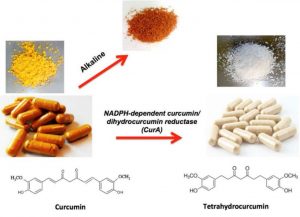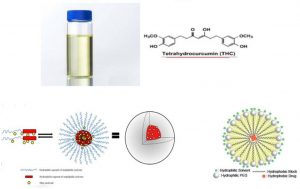Tetrahydrocurcumin (THC) is a semi-synthesized product from Curcumin, it exhibits many of the same physiologic and pharmacological activities as curcumin but at higher levels of effectiveness.

In general, THC is an antioxidative substance, anti-inflammatory element and antimicrobial. According to many studies, THC is much more effective than Curcumin in the same purpose of use, moreover, the range of microbial target and medical treatment is larger:
• Antioxidative substance: THC was found to be the most active compound compared to curcumin and trolox at all concentrations tested in scavenging of superoxide anion [1]
• Antidiabetic action: THC helps control glucose level in blood, reducing risk of diabetes [2]
• Anticarcinogenic attributes: due to anti-inflammatory ability, THC inhibits the development and spearding of tumor cells [3]
On the other hand, THC encounters the same disadvantages like Curcumin, its dispersion ability in water is extremely poor and it is sensitive to surrounding environment at ambient temperature. Consequently, its ultilization and effectiveness meets hug obstacle in reality.
Hence, Wakanomo had researched and developed newly modernized THC at nano scale to eliminate the drawbacks and maximize the effects of THC.

With advantages of Nano technology, there are several characteristic of THC enhanced:
• It is fully dispersed in water helping more flexible to apply into realitic product like food, cosmetic or supplement dietary
• It can deeply penetrate through intestine barrier leading the increase in absorption
• THC concentration is remained through stomach digestion due to protective layer
• THC nanoparticle is endurable with sunlight and oxidative agents. [4]
THC is a preeminent biological active substance, with the creation of nano THC, those bioactivities will bring maximum benefits in medical treatment. Nano THC is the basis for widespread application of THC in commercial products as the physical and chemical disadvantages of THC have been innovated.
References
[1] Prabhu P.R., Hegde K., et al.,“Scavenging potential of reactive oxygen species by Tetra-hydrocurcumin”, Journal of Applied Pharmaceutical Science, 01 (05), 114 -118, (2011)
[2] Murugan, P. & Pari, L., “Antioxidant effect of tetrahydrocurcumin in streptozotocin-nicotinamide induced diabetic rats.”, Life Sciences, 79 (18), (2006) 1720-1728.
[3] Yoysungnoen B., et al., “Effects of Tetrahydrocurcumin on Tumor Growth and Cellular Signaling in Cervical Cancer Xenografts in Nude Mice”, BioMed Research International, 2016.
[4] Songtipya, Ladawan, Mark C. Thies, and Amporn Sane. “Effect of rapid expansion of subcritical solutions processing conditions on loading capacity of tetrahydrocurcumin encapsulated in poly (l-lactide) particles.” The Journal of Supercritical Fluids 113 (2016): 119-127